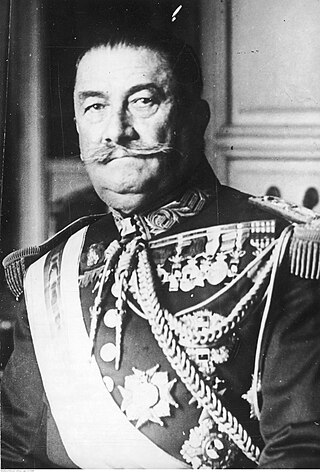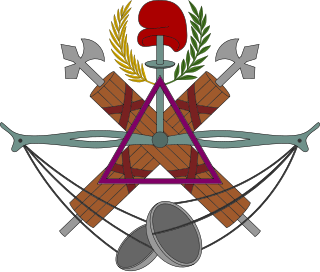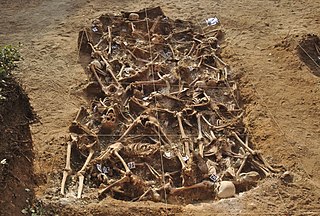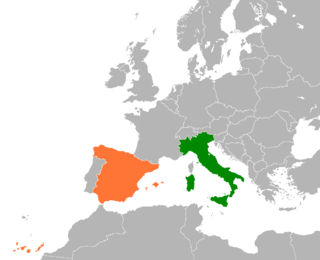Related Research Articles

Francoist Spain, also known as the Francoist dictatorship, was the period of Spanish history between 1936 and 1975, when Francisco Franco ruled Spain after the Spanish Civil War with the title Caudillo. After his death in 1975, Spain transitioned into a democracy. During this time period, Spain was officially known as the Spanish State.

Dámaso Berenguer y Fusté, 1st Count of Xauen was a Spanish general and politician. He served as Prime Minister during the last thirteen months of the reign of Alfonso XIII.

The 1977 Spanish general election was held on Wednesday, 15 June 1977, to elect the Spanish Cortes of the Kingdom of Spain. All 350 seats in the Congress of Deputies were up for election, as well as all 207 seats in the Senate.

The Radical Republican Party, sometimes shortened to the Radical Party, was a Spanish Radical party in existence between 1908 and 1936. Beginning as a splinter from earlier Radical parties, it initially played a minor role in Spanish parliamentary life, before it came to prominence as one of the leading political forces of the Spanish Republic.

The Maquis were Spanish guerrillas who waged an irregular warfare against the Francoist dictatorship within Spain following the Republican defeat in the Spanish Civil War until the early 1960s, carrying out sabotage, robberies and assassinations of alleged Francoists as well as contributing to the fight against Nazi Germany and the Vichy regime in France during World War II. They also took part in occupations of the Spanish embassy in France.

In the history of Spain, the White Terror describes the political repression, including executions and rapes, which were carried out by the Nationalist faction during the Spanish Civil War (1936–1939), as well as during the following years of the regime of General Francisco Franco. In the 1936–1975 period, Francoist Spain had many officially designated enemies: Loyalists to the Second Spanish Republic (1931–1939), Liberals, socialists of different stripes, Protestants, intellectuals, homosexuals, Freemasons, Romanis, Jews, blacks, immigrants, Basque, Catalan, Andalusian and Galician nationalists.
Pistolerismo refers both to a specific period of Spanish history, between the general strike of August 1917 and Primo de Rivera's coup in September 1923, and to the social phenomenon spread in many areas of Spain during which Spanish employers hired thugs to face and often kill trade unionists and notable workers – and vice versa. It was characterized by the birth and proliferation of several armed groups composed of pistoleros, specialized men in the use of violence.

Italy–Spain relations are the interstate relations between Italy and Spain. Both countries established diplomatic relations some time after the unification of Italy in 1860.
Esteban de Bilbao Eguía, 1st Marquess of Bilbao Eguía was a Spanish politician during the dictatorship of Francisco Franco.

The Revolution of 1934, also known as the Revolution of October 1934 or the Revolutionary General Strike of 1934, was a revolutionary strike movement that took place between 5 and 19 October 1934, during the black biennium of the Second Spanish Republic. The revolts were triggered by the entry of the conservative Spanish Confederation of the Autonomous Right (CEDA) into the Spanish government. Most of the events occurred in Catalonia and Asturias and were supported by many Spanish Socialist Workers' Party (PSOE) and General Union of Workers (UGT) members, notably Largo Caballero, as well as members of the Confederación Nacional del Trabajo (CNT). Historians have argued that the incident sharpened antagonism between the political Right and Left in Spain and was part of the reason for the later Spanish Civil War. Around 2,000 people were killed during the uprising, which was repressed by Spanish government forces.

The last use of capital punishment in Spain took place on 27 September 1975 when two members of the armed Basque nationalist and separatist group ETA political-military and three members of the Revolutionary Antifascist Patriotic Front (FRAP) were executed by firing squads after having been convicted and sentenced to death by military tribunals for the murder of policemen and civil guards. Spain was Western Europe's only dictatorship at the time and had been unpopular and internationally isolated in the post-war period due to its relations with Nazi Germany in the 1930s and 1940s and the fact that its autocratic leader, Francisco Franco, had come to power by overthrowing a democratically elected government. As a result, the executions resulted in substantial criticism of the Spanish government, both domestically and abroad. Reactions included street protests, attacks on Spanish embassies, international criticism of the Spanish government and diplomatic measures, such as the withdrawal of the ambassadors of fifteen European countries.
Javier Tusell Gómez was a Spanish historian, writer and politician who served as a professor of modern history at the National University of Distance Education (UNED).
The Sabaté brothers Quico and Pepe were among the famed Catalan Spanish maquis and urban guerrilla of the Francoist post-Civil War period. They participated in an anarchist guerrilla vigilante group of expropriators before the war. Afterwards, as maquis, they turned their focus from unlikely anarchist mass insurrection to converting others to anti-Francoism. The maquis descended from exile in the French Pyrenees to the Barcelona area, attacking Francoists and continuing vigilante robberies as a form of propaganda by deed. Their youngest brother, Manolo, rode with another maquis in defiance of his brothers' request that he pursue other work. Manolo was quickly caught in a police trap and executed by firing squad in 1949 at Barcelona's El Camp de la Bóta, the notorious execution grounds of the Franco period.
Daniel Cardona i Civit, also known with the pen name of Vibrant or the nickname of l'Irlandès, was a Catalan politician, a prominent figure of 20th-century radical Catalan separatism.

Women prisoners in Francoist Spain were often there because of specific repression aimed at women. During the Civil War, many women were in prison because family members had Republican sympathies or the authorities wanted to lure out male Republican affiliated relatives; it was not a result of anything the women did themselves. The Law of Political Responsibilities, adopted on 13 February 1939, made such repression easier and was not formally removed from the Criminal Code until 1966. Prisoners and people in concentration camps, both male and female, would total over three quarters of a million by the end of the Spanish Civil War. Of these, 14,000 women were held in Las Ventas Model prison in Madrid.

Ángel Viñas Martín is a Spanish economist and historian. He has published many works dealing with the Spanish Civil War focusing on the war finance as well as the international relations aspects of the conflict.
Manuel Díaz Criado was a Spanish infantry officer. With a reputation as a brutal sadist, he was during the Spanish Civil War responsible for the arrest, sexual abuse, torture and execution of thousands of people in the regions of Andalucia and Extremadura who opposed the Nationalist military uprising. The crimes frequently extended to the relatives and the associates of those targeted.

The Junta Técnica del Estado was one of several political-administrative bodies created by General Franco in October 1936 after his appointment as head of government of rebel Spain during the Spanish Civil War. It was one of the main institutions that made up the first governmental organization created by Franco. Although it was divided into sectorial commissions, it was not a real government and was composed of personalities with little political relevance. It was successively presided over by Generals Dávila and Jordana. It disappeared with the creation of Franco's first proper government in February 1938.

The coup d'état of Primo de Rivera took place in Spain between September 13 and 15, 1923 and was led by the then Captain General of Catalonia Miguel Primo de Rivera. It resulted in the establishment of the dictatorship of Primo de Rivera, mainly because King Alfonso XIII did not oppose the coup and appointed the rebel general as head of the Government at the head of a Militar Directory.
The Law of Jurisdictions, or "Law for the Repression of Crimes against the Motherland and the Army", was a Spanish law that was in effect between 1906 and 1931. It was promoted by Segismundo Moret, president of the Council of Ministers, and the Count of Romanones, Ministry of Government, with the support of Alfonso XIII, as a reaction to the events of the ¡Cu-Cut! It was approved during the constitutional period of the reign of Alfonso XIII.
References
- ↑ Fuente, Vicente de la (1870), Historia de las sociedades secretas antiguas y modernas en España, y especialmente de la franc-masonería, Lugo, Imprenta de Soto Freire, p. 410.
- ↑ Tusell, Javier (1981). "Un año de dictadura". Historia 16. 58: 36.
- ↑ Tusell, Javier (1995-01-06). "GAL: Las sorpresas del atajo". El País (in Spanish). ISSN 1134-6582 . Retrieved 2022-10-08.
- ↑ "La teoría y la práctica del esperpento - Cátedra Valle-Inclán". Biblioteca Virtual Miguel de Cervantes (in Spanish). Retrieved 2022-10-08.
- ↑ Pasalodos, Arnau Fernández (2021). "LA "LEY DE FUGAS" DURANTE LA LUCHA ANTIGUERRILLERA EN ESPAÑA (1936-1952): EL EXTERMINIO POR ENCIMA DE LA IMAGEN INTERNACIONAL". Historia Social (101): 125–144. ISSN 0214-2570. JSTOR 48621945.
- ↑ Mondragon Aguirre, Magdalena (1982). México pelado : ópero sabroso! (7a impr ed.). México: Diane. pp. 302–304. ISBN 968-13-0917-0. OCLC 651188416.
- ↑ Lund, Joshua (2017). El estado mestizo. Ciudad de México: Malpaso Ediciones. ISBN 978-84-16665-97-6. OCLC 1083468135.
- ↑ "La sangrienta ley de fuga de la dictadura" (in Spanish). 21 August 2012.
- ↑ "Un coronel confirmó que había ley de fugas" (in Spanish).
- ↑ Aguirre, Mariano (18 November 1976). "Aumenta la aplicación de la "Ley de fugas" a los presos políticos". El País (in Spanish).